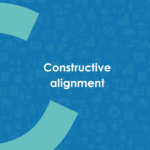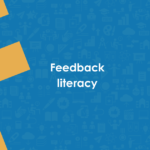
22 Apr Formative assessment
How nice it would be if for once students stopped thinking only about grades and, in the first place, learned from their assignment. Time to use formative assessment! In good spirits, you set to work. You decide that one of the assignments in your course will no longer result in grades, but that everyone will only receive feedback. It takes a lot of work but it’s worth it. Or isn’t it? The students’ focus suddenly shifts. You can hear them saying, ‘This is not for grades anyway so I didn’t really spend time on this.’ What went wrong?
Formative assessment is often referred to as the counterpart of summative assessment. The idea is that there is evaluation where a final judgement is attached such as a pass/fail decision -summative-, and there is evaluation where learning is central – formative-. Kneyber et al (2022) wrote a book on formative assessment and deliberately abandoned the word ‘assessment’ or ‘evaluation’. They use the term ‘formatief handelen’ which translates as ‘formative practice’. Too often the misconception still exists that if an exam or test is taken without scoring, formative assessment is involved. Actually, formative assessment is a concept that is not about evaluation at all.
What is formative assessment?
Formative assessment is a didactic process that you use in your lessons, thus it is not evaluation or testing¹. Formative assessment is not necessarily about knowing whether learning has taken place, but mainly about knowing what has been learned. You gather information about what has been learned in active collaboration with students. It is then important to clarify what the information means so that you can do something with it. Preferably as quickly as possible, such as in a subsequent lesson, and without major administration. Using formative assessment aims to improve lessons and the learning process². Among other things, it enhances learner motivation, improves understanding of lesson material and promotes self-regulation skills.
An example
You are curious to see if your students have mastered the material in your subject and have chosen two concepts that the students really need to understand before they can move on to the next lesson. So, the students have to answer two multiple-choice questions about the concepts by raising their fingers. This way, you immediately have an overview of who has mastered the material. It turns out that half the group does not yet understand one of the concepts. The answer they gave makes it clear which misconception is still alive. You then give the students several options: continue with the material, do a repeat exercise, or ask a fellow student for extra explanation. By dwelling on the preceding material, the lessons after this are more effective.
Of course, this example is not exhaustive; there are many ways to use formative assessment, depending on your context and your goal. Because formative assessment is an ongoing process, it will not be successful if you use just one exam or test in a formative way, for instance. You will have to think about the bigger picture of your educational design and the place formative assessment has in it.
Implementing formative assessment
Formative assessment is a great way to ensure constructive alignment during the implementation of your teaching. Earlier, we wrote about constructive alignment: aligning objectives, learning activities and assessment. Here it already became clear that actually achieving good alignment is not that easy. If you have created an educational design in which you have tried to align objectives and activities as much as possible, it can still happen that a learning activity does not contribute to the objectives as you had imagined. After all, practice is not always the same as theory.
In such cases, formative assessment is a good way of ensuring constructive alignment even during the actual implementation of your design. You check where students are in their learning, and adjust your teaching where necessary. It also means that your curriculum should not be too full, otherwise there is no room for possible adjustments. This requires making choices, which are not always easy. But the choices do pay off in a more effective learning process.
Ownership to students
Ultimately, we hope to turn students into independent professionals who are no longer dependent on the teacher. Formative assessment contributes to students’ self-regulation skills. Formative assessment can be seen as a form of coregulation in which you and the student develop an understanding of where they stand in their learning and what the next steps are. You help the student to gather more and more information about the learning process by himself, to ask for feedback when needed, and to process this feedback effectively to make a good next step.
One way to increase students’ role in that coregulation is, for example, by instilling in them a sense of quality¹. Simply sharing objectives and assessment criteria does not work for this purpose. It is known that comparing examples works very well to instil quality awareness. In addition, it is important to design the feedback process in such a way that students themselves think about feedback and are encouraged to take action. Among other things, this means moving away from the idea that feedback always looks like a teacher’s commentary on a student.
Comproved helps
Comproved can help both to promote quality awareness among students and to design the feedback process more effectively. In Comproved, each student receives feedback (anonymously) from multiple peers and/or lecturers. This will make students actively think about their next steps: what if the feedback contradicts each other? What do they themselves actually think? Comproved then works with a feedback action plan in which the feedback is categorised and follow-up steps are formulated by the students themselves. Want to know more about how this works? Read more here.
Implementing formative assessment effectively requires a good understanding of the concept and practice. We highly recommend the book by Kneyber et al. if you want to continue working with this concept, or consult the Toetsrevolutie website (in Dutch).
Literature
¹Kneyber, R., Sluijsmans, D., Devid, V., & Wilde López, B. (2022). Formatief handelen: van instrument naar ontwerp. Phronese.
²Kruiper, S. M. A., Leenknecht, M. J. M., & Slof, B. (2022). Using scaffolding strategies to improve formative assessment practice in higher education. Assessment & Evaluation in Higher Education, 47(3), 458-276. https://doi.org/10.1080/02602938.2021.1927981




